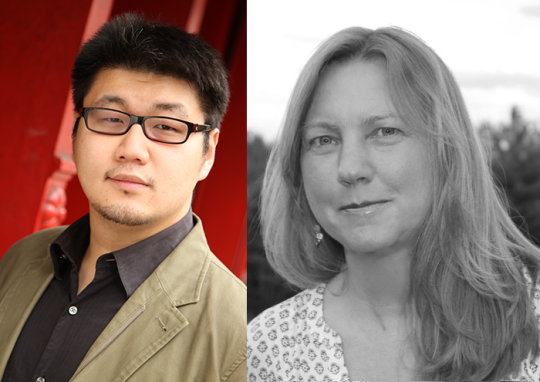Conversations: Susan Karwoska Interviews Bill Cheng
“Blues is a kind of art form that is without boundaries; it doesn’t matter who you are, where you’re from—if you’re ready to receive it, it can change how you see.”
Bill Cheng is the author of Southern Cross the Dog (Ecco Press, 2013). His fiction has appeared and been collected in Guernica, The Book of Men, and Tales of Two Cities: The Best and Worst of Times in Today’s New York. He is the recipient of a 2015 Fellowship in Fiction from the New York Foundation for the Arts and received his MFA from Hunter College.
Susan Karwoska (Fellow in Fiction, 2012 and Advisory Board member) conducted this interview with Bill by email in September 2015.
Susan Karwoska: First of all, congratulations on receiving a NYFA Fiction Fellowship this year. I served on the fiction panel and believe me, the competition was fierce. One of the unique things about this award is that it can be given to a young unpublished writer or to a well-known author—the writing is everything—but I have the sense that it means different things to writers at different stages of their careers. As someone who just published a debut novel to much acclaim, what does it mean to you to be selected as a NYFA Fellow?
Bill Cheng: I won’t lie—it feels good. It makes it easier to walk into a room with your peers and not feel like a total fraud all the time. I don’t know; I’m a weak animal. As much as I hate this part of me, I need someone to look at what I’m doing and say, “This is good.” It’s not healthy for a writer, or anyone really, to live for that kind of affirmation but it’s also hard to resist. Writing is so solitary. You can slip out of sync with the world if you’re not careful.
SK: The novelist Jane Smiley, writing in The Guardian, said that you made your debut novel, Southern Cross the Dog “out of fascination and research,” and many reviewers have commented on the fact that you are a Chinese-American born and raised in Queens writing about a young black man living in the Jim Crow-era Deep South, a place you did not visit until after you finished the novel. What was it that drew you to this particular time and place, and was it complicated to lay claim to a story so far removed from your own?
BC: The book came to me at a time when I was deep into blues music. I think blues is a kind of art form that is without boundaries; it doesn’t matter who you are, where you’re from—if you’re ready to receive it, it can change how you see. But the blues is also of a particular place, of a particular time, telling very particular stories. I wanted to write a book that honored that.
SK: The language in Southern Cross the Dog is lyrical and haunting, suffused with the mythology and melancholy of the blues. You dedicated the book to “all the late, great bluesmen” and claim a life-long passion for the form. What is it that draws you to the blues? And did this interest make it easier for you to develop the voice of the novel, or did it take you a while to find it?
BC: I was into the music before I wanted to write this book, so for years I’d been filling myself with this music every day. These voices. Their stories. I read a lot about the region, about different musicians. Keep in mind, I wasn’t thinking of it as preparation. I was just trying to enrich myself. For me, blues is a way to not only express grief and pain and sorrow, but also a means to be communal in that sorrow. To find joy and hope at the other side of it.
As for the voice, it’s hard to say. I think, actually, blues music has a language that’s different from the way I usually write. The lyrics can be very plain and direct and declarative, but in its rendering, it’s made complex and beautiful and nuanced. Its depth grows in its repetition, in locating its meaning within the song itself, within other songs around it. It’s really a magical thing and not something I’ve seen pulled off perfectly on the page.
SK: The book is also filled with descriptions of the Mississippi landscape of the early 20th century: the forests and swamps and fields, the houses, brothels, towns, and people of that era. What enabled you to write about this landscape and the people who inhabited it with such precise and evocative detail?
BC: Some combination of faith, audacity, mulishness, research, and force of will. Basic writer fare, I think.
SK: The precipitating event of the novel is the Great Mississippi Flood of 1927, one of the most destructive floods in U.S. history. Your descriptions of the devastation it wreaked bare eerie similarities to the images of devastation we saw in New Orleans after Hurricane Katrina. Are there other parallels you saw between these two places in the aftermath of the floods that occurred there and did they influence the writing of your book in any way?
BC: Not really. I didn’t really make that connection until after I was deep into my first draft. If I were actively writing about Katrina, I think it would be a different book. For me—and I hate actually saying this out loud—the book was more supposed to capture that feeling of tenuousness post-9/11. The feeling of having the ground disappear underneath you, of being perpetually unsafe and unrooted.
SK: Your writing has been compared to William Faulkner and Cormac McCarthy. Do you see yourself as working a similar territory in American fiction? Who are the writers who inspire you?
BC: I think this book tries to operate in that same space as Faulkner and McCarthy and Flannery O’Connor. There are also a lot of great writers continuing in that tradition—Philipp Meyer, Smith Henderson, Wiley Cash, Jesmyn Ward. But I don’t know if that’s what my work is going to be like moving forward. If the universe is kind, I’ll have a writing career where each book is diverse in focus and ambition.
As for the writers who inspire me—that’s tough for me. There are, of course, the people who’ve taught me at my MFA. Colum McCann, Peter Carey, Nathan Englander, Claire Messud. I don’t mean this to read as some kind of lip-service. It’s not. They’re the people who inspire me to write. I read their books and am dazzled by their stories, their language, their scope; I am humbled by their intellect; they are the models for who I want to be and how I want to act in the world. Period.
Then there are the big literary touchstones over the course of my life: The two Raymonds, Carver and Chandler, were both really important to me early on. Walter Mosley. Peter Matthiessen. The late Kent Haruf. Michael Ondaatje. But there are also a ton of writers working today who you can’t help but be staggered by how they’re shaping the times in which they live: Junot Diaz. Marilyn Chin. Kiese Laymon. Tiphanie Yanique.
I always hate this question because I feel like my answer is always insufficient. So I’ll just say Tom Waits.
SK: You received a BA in creative writing from Baruch College, and a MFA from Hunter College. How important were these programs in helping you become the writer you are?
BC: Yeah, I’m a CUNY kid all the way through. They were essential. I really don’t know what kind of writer I’d be without the people I met at both those places. Baruch has a sort of sleeper writer-in-residency program called the Sidney Harman Writer-in-Residence Program. It has consistently brought great writers to students for over a decade. As a shy, dorky, risk-averse undergraduate, it gave me the space to imagine myself as someone who could be like them.
Hunter was a continuation of that. It’s where I developed my ethos, my work ethic, my conscience. It’s where I found my community. I don’t know if there’s anything more you can get out of a writing program.
SK: What are you working on now, and how soon will we get to see it?
BC: I’m playing the new stuff pretty close to the vest. Whoever is coming to the NYFA reading at NYU in October will get a small taste of it though.
– Susan Karwoska
Bill will be reading at NYU on October 9 as part of NYFA Presents: Three Decades of Writing Fellows to celebrate the 30th Anniversary of the Artists’ Fellowship Program with Luc Sante (Fellow in Non-Fiction ‘14), Dana Spiotta (Fellow in Fiction ‘08) and NYFA Board member and three-time fellowship recipient Saïd Sayrafiezadeh, who is hosting the event.
Date: Friday, October 9, 2015, 5:00 PM
Where: Lillian Vernon Creative Writers House, 58 West 10th Street, between 5th and 6th Avenues
More information: http://current.nyfa.org/post/128137849288/nyfa-presents-three-decades-of-writing-fellows
Details on NYFA’s 30th Anniversary of our Artists’ Fellowship Program can be found on our website here.
Image: Photo of Bill Cheng by Joe Orecchio.





